高职英语课程设计Vocational College English Curriculum Design
- 格式:ppt
- 大小:1.45 MB
- 文档页数:1
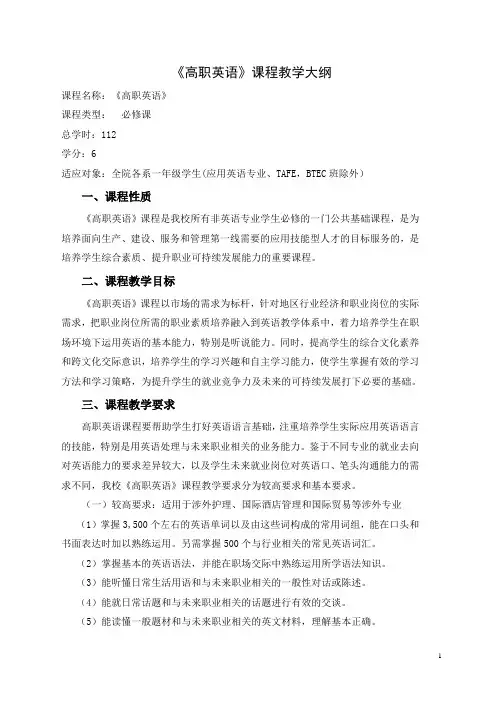
《高职英语》课程教学大纲课程名称:《高职英语》课程类型:必修课总学时:112学分:6适应对象:全院各系一年级学生(应用英语专业、TAFE,BTEC班除外)一、课程性质《高职英语》课程是我校所有非英语专业学生必修的一门公共基础课程,是为培养面向生产、建设、服务和管理第一线需要的应用技能型人才的目标服务的,是培养学生综合素质、提升职业可持续发展能力的重要课程。
二、课程教学目标《高职英语》课程以市场的需求为标杆,针对地区行业经济和职业岗位的实际需求,把职业岗位所需的职业素质培养融入到英语教学体系中,着力培养学生在职场环境下运用英语的基本能力,特别是听说能力。
同时,提高学生的综合文化素养和跨文化交际意识,培养学生的学习兴趣和自主学习能力,使学生掌握有效的学习方法和学习策略,为提升学生的就业竞争力及未来的可持续发展打下必要的基础。
三、课程教学要求高职英语课程要帮助学生打好英语语言基础,注重培养学生实际应用英语语言的技能,特别是用英语处理与未来职业相关的业务能力。
鉴于不同专业的就业去向对英语能力的要求差异较大,以及学生未来就业岗位对英语口、笔头沟通能力的需求不同,我校《高职英语》课程教学要求分为较高要求和基本要求。
(一)较高要求:适用于涉外护理、国际酒店管理和国际贸易等涉外专业(1)掌握3,500个左右的英语单词以及由这些词构成的常用词组,能在口头和书面表达时加以熟练运用。
另需掌握500个与行业相关的常见英语词汇。
(2)掌握基本的英语语法,并能在职场交际中熟练运用所学语法知识。
(3)能听懂日常生活用语和与未来职业相关的一般性对话或陈述。
(4)能就日常话题和与未来职业相关的话题进行有效的交谈。
(5)能读懂一般题材和与未来职业相关的英文材料,理解基本正确。
(6)能就一般性话题写命题作文,能模拟套写与未来职业相关的英语应用文,如信函、通知、个人简历等。
内容基本完整,表达基本准确,语义连贯,格式恰当。
(7)能借助词典将一般性题材的文字材料和与未来职业相关的业务材料译成汉语。
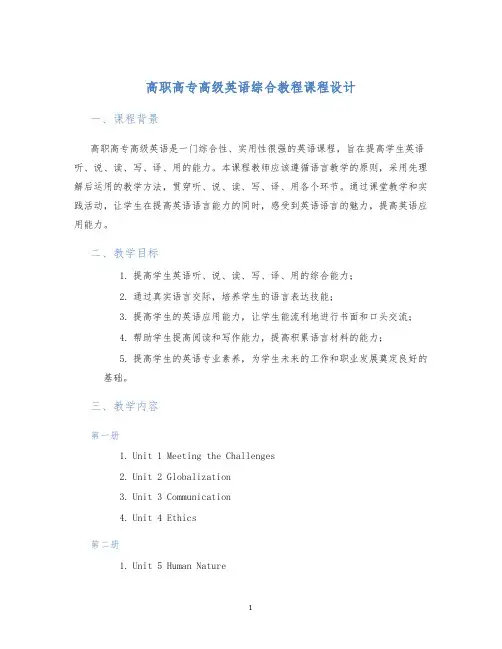
高职高专高级英语综合教程课程设计一、课程背景高职高专高级英语是一门综合性、实用性很强的英语课程,旨在提高学生英语听、说、读、写、译、用的能力。
本课程教师应该遵循语言教学的原则,采用先理解后运用的教学方法,贯穿听、说、读、写、译、用各个环节。
通过课堂教学和实践活动,让学生在提高英语语言能力的同时,感受到英语语言的魅力,提高英语应用能力。
二、教学目标1.提高学生英语听、说、读、写、译、用的综合能力;2.通过真实语言交际,培养学生的语言表达技能;3.提高学生的英语应用能力,让学生能流利地进行书面和口头交流;4.帮助学生提高阅读和写作能力,提高积累语言材料的能力;5.提高学生的英语专业素养,为学生未来的工作和职业发展奠定良好的基础。
三、教学内容第一册1.Unit 1 Meeting the Challenges2.Unit 2 Globalization3.Unit 3 Communication4.Unit 4 Ethics第二册1.Unit 5 Human Nature2.Unit 6 Revolution and Progress3.Unit 7 Lifestyles4.Unit 8 Youth and Age第三册1.Unit 9 Health2.Unit 10 Education3.Unit 11 The Environment4.Unit 12 The Future四、教学方法1.先授听力,让学生提高听力和理解水平;2.听完后,进行讨论和问答,让学生表达自己的观点和看法;3.模仿和角色扮演,让学生在模拟真实情境中训练语言交际能力;4.课堂练习、作业和写作等各种形式,让学生通过大量的练习提高英语应用能力;5.通过扩大词汇量、提高语法知识、增加语言实践等来提高学生的语言能力。
五、考核方式1.期末英语综合测验,包括听力、阅读、写作和口语;2.平时作业,包括听力练习、课堂表现、小组讨论等;3.语言表达能力测试,包括英语演讲、英语听力、日常英语交流等。
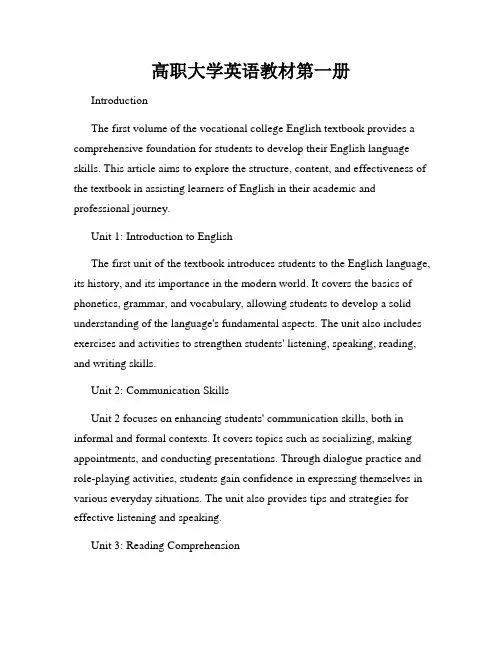
高职大学英语教材第一册IntroductionThe first volume of the vocational college English textbook provides a comprehensive foundation for students to develop their English language skills. This article aims to explore the structure, content, and effectiveness of the textbook in assisting learners of English in their academic and professional journey.Unit 1: Introduction to EnglishThe first unit of the textbook introduces students to the English language, its history, and its importance in the modern world. It covers the basics of phonetics, grammar, and vocabulary, allowing students to develop a solid understanding of the language's fundamental aspects. The unit also includes exercises and activities to strengthen students' listening, speaking, reading, and writing skills.Unit 2: Communication SkillsUnit 2 focuses on enhancing students' communication skills, both in informal and formal contexts. It covers topics such as socializing, making appointments, and conducting presentations. Through dialogue practice and role-playing activities, students gain confidence in expressing themselves in various everyday situations. The unit also provides tips and strategies for effective listening and speaking.Unit 3: Reading ComprehensionUnit 3 aims to improve students' reading comprehension abilities. It introduces different reading strategies such as skimming, scanning, and inference. The unit includes a variety of texts, including newspaper articles, essays, and literary excerpts. These texts cover a wide range of topics, allowing students to expand their knowledge while honing their reading skills.Unit 4: Writing SkillsUnit 4 focuses on developing students' writing skills by providing step-by-step guidance on different types of writing, such as emails, reports, and essays. It emphasizes the importance of planning, organizing ideas, and proofreading. The unit also includes grammar and vocabulary exercises to enhance students' writing fluency and accuracy.Unit 5: Listening and SpeakingUnit 5 aims to improve students' listening and speaking skills through a variety of audio materials and interactive activities. It covers different listening strategies and provides opportunities for students to practice their listening comprehension. The unit also includes speaking tasks that encourage students to express their opinions, engage in discussions, and deliver presentations.Unit 6: Business EnglishUnit 6 introduces students to the basics of business English, including vocabulary related to finance, marketing, and management. It provides practical exercises and case studies to familiarize students with the language used in a professional setting. The unit also emphasizes effectivecommunication skills in business contexts, such as making phone calls, negotiating, and writing business correspondence.ConclusionThe first volume of the vocational college English textbook provides a comprehensive curriculum for students to develop their English language skills. It covers essential aspects of the language, including grammar, vocabulary, reading, writing, listening, and speaking. The textbook's structured approach and varied exercises enhance students' understanding and proficiency in English. By utilizing this textbook effectively, vocational college students can enhance their academic and professional prospects in an increasingly globalized world.。

高职英语教学设计Title: Design of English Teaching for Vocational CollegeIntroduction:English teaching in vocational colleges plays a crucial role in equipping students with practical language skills for their future careers. This article aims to present a well-structured and comprehensive design for high-quality English teaching in vocational college. It focuses on enhancing students' listening, speaking, reading, and writing abilities, as well as promoting their cultural understanding.1. Needs Analysis:To effectively design an English curriculum for vocational college students, a thorough needs analysis should be conducted. This analysis should include an evaluation of students' language proficiency levels, their career goals, and the specific English skills required in their chosen vocational fields. The findings from the needs analysis will form the foundation for designing appropriate learning objectives and content.2. Setting Learning Objectives:Based on the needs analysis, clear and measurable learning objectives should be established. These objectives should align with the specific language skills, vocabulary, and grammar structures that students need to develop. Learning objectives should be divided into short-term and long-term goals and should be revisited and revised throughout the course to ensure students' progress.3. Integrating Authentic Materials:To create an immersive language learning environment, teachers should incorporate authentic materials into their teaching. This may include newspaper articles, videos, podcasts, and authentic texts related to students' vocational fields. Authentic materials expose students to real-life language usage, helping them develop their language comprehension and usage skills.4. Communicative Language Teaching (CLT) Approach:Adopting the communicative language teaching approach can greatly enhance students' speaking and listening abilities. Engaging students in communicative activities, such as role-plays, group discussions, and debates, enables them to practice using English in real-life situations. Additionally, providing ample opportunities for pair and group work encourages students to actively participate and interact with their classmates, creating a dynamic learning environment.5. Task-based Learning:Task-based learning promotes active student participation and collaboration while developing their language skills. Designing tasks that simulate authentic vocational contexts allows students to apply their language knowledge and skills in real-life scenarios. Tasks can include writing industry-related reports, conducting interviews, or giving presentations on professional topics. These activities not only enhance language proficiency but also develop students' critical thinking and problem-solving abilities.6. Blended Learning:Incorporating technology into English teaching can greatly enhance students' learning experience. Blended learning combines face-to-face instruction with online resources and tools. Online platforms and interactive websites can provide additional practice opportunities for students, including self-paced exercises, multimedia materials, and online language exchanges. This approach allows students to access learning resources at their own convenience and encourages autonomous learning.7. Cultural Awareness:English teaching in vocational colleges should also emphasize cultural understanding. Introducing students to English-speaking cultures and encouraging them to explore cultural differences builds their cross-cultural communication skills. Including tasks such as researching cultural practices, studying international business etiquette, or analyzing global current events can broaden students' horizons and cultivate their global mindset.Conclusion:A well-designed English teaching plan for vocational college should prioritize students' language needs, integrate authentic materials, promote communicative language teaching, incorporate task-based learning, adopt blended learning, and foster cultural awareness. By implementing such a comprehensive teaching design, vocational college students can effectively develop their English language skills, preparing them for success in their future careers.。
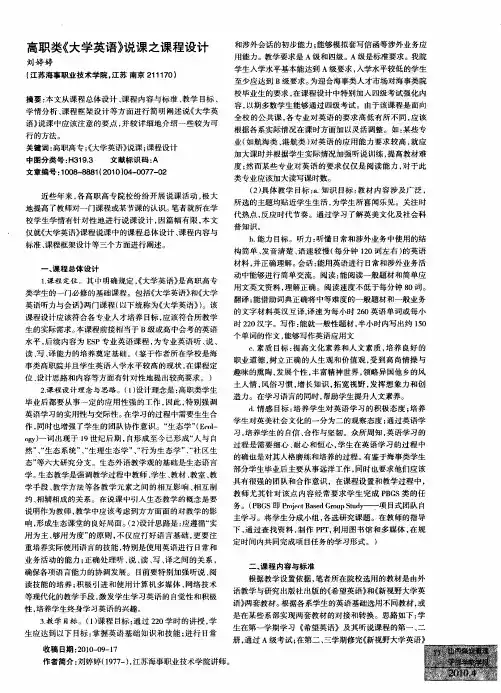

新世纪高职英语(第三版)第2册教案全文共3篇示例,供读者参考篇1Title: Teaching Plan for New Century Vocational College English (Third Edition) Volume 2Introduction:The New Century Vocational College English (Third Edition) Volume 2 is designed for students in vocational colleges and institutes to improve their English language skills. This teaching plan aims to provide teachers with a detailed guide on how to effectively teach this textbook, covering topics such as lesson objectives, teaching methods, and assessment strategies.Lesson Objectives:1. To enhance students' listening and speaking skills through various activities such as role plays, group discussions, and listening exercises.2. To improve students' reading comprehension and vocabulary acquisition by introducing them to a wide range of texts and vocabulary items.3. To develop students' writing skills by guiding them through the process of writing essays, reports, and summaries.4. To familiarize students with different aspects of English culture and society through reading materials and discussions.Teaching Methods:1. Lecture-based instruction: Teachers can use lecture-based instruction to introduce new vocabulary items, grammar points, and reading materials.2. Group work: Group work activities, such as group discussions and role plays, can help students practice their speaking and listening skills in a supportive environment.3. Pair work: Pair work activities, such as debates and interviews, can give students the opportunity to interact with their peers and improve their communication skills.4. Multimedia resources: Teachers can use multimedia resources, such as videos and online articles, to supplement the textbook and provide students with additional learning opportunities.Assessment Strategies:1. Quizzes and tests: Teachers can use quizzes and tests to assess students' understanding of the material covered in each unit.2. Oral presentations: Oral presentations can be used to evaluate students' speaking skills and their ability to communicate effectively.3. Written assignments: Written assignments, such as essays and reports, can be used to assess students' writing skills and their ability to organize and present information.Conclusion:The New Century Vocational College English (Third Edition) Volume 2 is a comprehensive textbook that can help students improve their English language skills in a vocational college setting. By following this teaching plan and implementing various teaching methods and assessment strategies, teachers can create a dynamic and engaging learning environment that will benefit students in their language learning journey.篇2《New Century Vocational College English (Third Edition) Volume 2 Lesson Plan》Unit 1: TravelObjectives:- To introduce students to vocabulary related to travel and transportation- To practice speaking about travel experiences- To develop listening skills through travel-related audio materials- To enhance writing skills by writing short paragraphs about travel destinationsLesson 1: Introduction to Travel- Vocabulary: airport, hotel, tourist attraction, passport, boarding pass, etc.- Discussion: What are your favorite travel destinations? Why?- Listening activity: Listen to a dialogue at the airport and answer questions- Writing task: Write about a dream vacation destinationLesson 2: Modes of Transportation- Vocabulary: train, bus, plane, car, bicycle, etc.- Discussion: What is the most convenient mode of transportation for you? Why?- Listening activity: Listen to a conversation about renting a car- Speaking task: Discuss the advantages and disadvantages of different modes of transportationUnit 2: Food and DiningObjectives:- To introduce students to vocabulary related to food and dining- To practice ordering food in a restaurant- To develop listening skills through food-related audio materials- To enhance writing skills by describing favorite dishesLesson 3: Food Vocabulary- Vocabulary: appetizer, main course, dessert, beverage, etc.- Discussion: What is your favorite type of cuisine? Why?- Listening activity: Listen to a conversation in a restaurant and answer questions- Writing task: Describe your favorite meal in detailLesson 4: Dining Etiquette- Vocabulary: reservation, tipping, menu, waiter, etc.- Discussion: What are the dining customs in your country?- Listening activity: Listen to a dialogue about dining etiquette- Role play: Practice ordering food in a restaurantUnit 3: TechnologyObjectives:- To introduce students to vocabulary related to technology and gadgets- To practice discussing the impact of technology on daily life- To develop listening skills through technology-related audio materials- To enhance writing skills by describing favorite gadgetsLesson 5: Technology Vocabulary- Vocabulary: smartphone, tablet, laptop, internet, social media, etc.- Discussion: How has technology changed the way we communicate?- Listening activity: Listen to a conversation about the pros and cons of social media- Writing task: Describe a gadget that you cannot live withoutLesson 6: The Future of Technology- Vocabulary: artificial intelligence, virtual reality, robotics, innovation, etc.- Discussion: How do you think technology will continue to evolve in the future?- Listening activity: Listen to a podcast about the future of technology- Debate: Discuss the ethical implications of advanced technologyOverall, the lessons in this unit focus on real-life scenarios and practical language skills that students can apply in their daily lives. These lessons aim to engage students through interactiveactivities and discussions while also building their confidence in using English in various contexts. By the end of this unit, students will have improved their vocabulary, speaking, listening, and writing skills, making them more proficient in English for travel, dining, and technology-related situations.篇3《New Century College English (Third Edition) Book 2 Teaching Plan》Unit 1Teaching Objectives:1. Understand the main idea and structure of the text.2. Learn new words and phrases.3. Develop listening and speaking skills.4. Improve reading and writing skills.Teaching Procedures:1. Pre-Reading Activities- Show students some pictures related to the topic of the text and ask them to make predictions about the content.- Introduce key vocabulary words and phrases.2. While-Reading Activities- Ask students to read the text silently and underline any unfamiliar words.- Divide the text into sections and have students discuss the main idea of each section.- Have students read the text aloud and discuss any difficult sentences.3. Post-Reading Activities- Ask students comprehension questions about the text.- Have students summarize the main points of the text.- Conduct a group discussion on the themes and concepts presented in the text.4. Vocabulary Practice- Have students match the vocabulary words with their definitions.- Ask students to use the new words and phrases in sentences of their own.5. Listening and Speaking Activities- Play a recording of the text and have students listen for specific information.- Conduct a role-play activity based on the dialogue in the text.6. Reading and Writing Activities- Ask students to write a summary of the text in their own words.- Have students write a response to a question related to the text.Unit 2Teaching Objectives:1. Understand and describe different cultural practices.2. Learn new vocabulary related to cultural diversity.3. Develop listening and speaking skills.4. Improve reading and writing skills.Teaching Procedures:1. Pre-Reading Activities- Discuss with students the importance of understanding different cultures.- Introduce key vocabulary words related to cultural practices.2. While-Reading Activities- Have students read the text and identify cultural practices mentioned.- Ask students to discuss the reasons behind cultural practices.3. Post-Reading Activities- Conduct a group discussion on the impact of globalization on cultural diversity.- Have students compare and contrast cultural practices in their own country with those mentioned in the text.4. Vocabulary Practice- Ask students to use the new vocabulary words and phrases in sentences.- Have students match the vocabulary words with their definitions.5. Listening and Speaking Activities- Play a recording of the text and have students listen for specific information.- Conduct a debate on the benefits and drawbacks of cultural diversity.6. Reading and Writing Activities- Ask students to write a reflective essay on the importance of cultural diversity.- Have students write a response to a question related to cultural practices.Overall, the teaching plan for《New Century College English (Third Edition) Book 2》focuses on developing students' language skills through various activities that engage and challenge them. By incorporating listening, speaking, reading, and writing activities, students are able to practice and improve their English proficiency in a fun and interactive way. Through the exploration of different topics and themes, students also gain a deeper understanding of the world around them and enhance their critical thinking skills.。
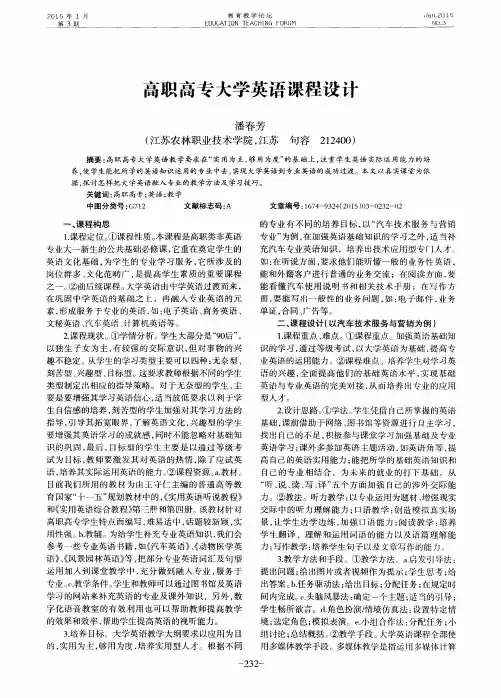
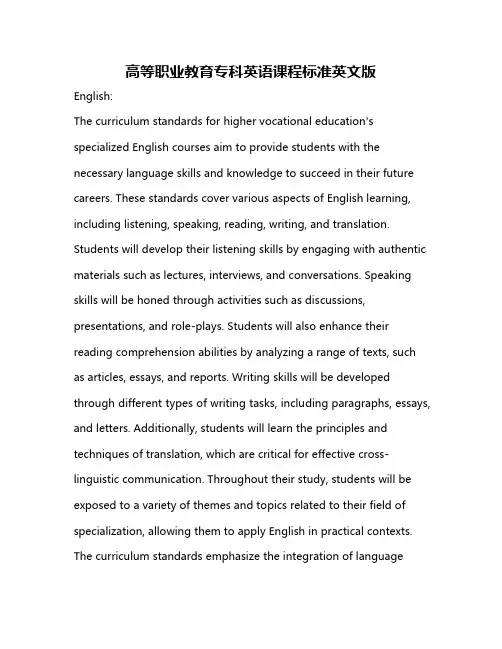
高等职业教育专科英语课程标准英文版English:The curriculum standards for higher vocational education's specialized English courses aim to provide students with the necessary language skills and knowledge to succeed in their future careers. These standards cover various aspects of English learning, including listening, speaking, reading, writing, and translation. Students will develop their listening skills by engaging with authentic materials such as lectures, interviews, and conversations. Speaking skills will be honed through activities such as discussions, presentations, and role-plays. Students will also enhance their reading comprehension abilities by analyzing a range of texts, such as articles, essays, and reports. Writing skills will be developed through different types of writing tasks, including paragraphs, essays, and letters. Additionally, students will learn the principles and techniques of translation, which are critical for effective cross-linguistic communication. Throughout their study, students will be exposed to a variety of themes and topics related to their field of specialization, allowing them to apply English in practical contexts. The curriculum standards emphasize the integration of languageskills and cross-cultural understanding, promoting students' ability to communicate effectively with people from different cultural backgrounds. Furthermore, the standards underscore the importance of incorporating technology and multimedia resources into language learning, enabling students to access and utilize information effectively. By meeting these standards, students will not only develop their English language proficiency but also acquire transferable skills that are highly valued in the job market.中文翻译:高等职业教育专科英语课程标准旨在为学生提供必要的语言技能和知识,以在未来的职业生涯中取得成功。
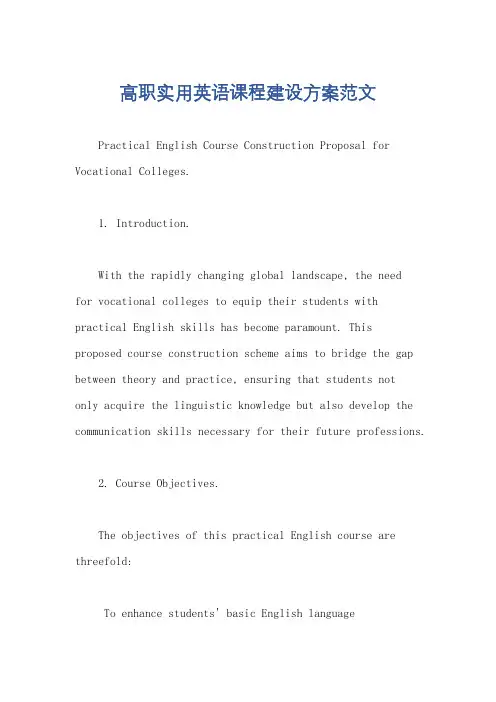
高职实用英语课程建设方案范文Practical English Course Construction Proposal for Vocational Colleges.1. Introduction.With the rapidly changing global landscape, the needfor vocational colleges to equip their students with practical English skills has become paramount. This proposed course construction scheme aims to bridge the gap between theory and practice, ensuring that students notonly acquire the linguistic knowledge but also develop the communication skills necessary for their future professions.2. Course Objectives.The objectives of this practical English course are threefold:To enhance students' basic English languageproficiency, including reading, writing, speaking, and listening.To equip students with the ability to use English effectively in their chosen vocational fields.To foster a culture of continuous learning and life-long development of English language skills.3. Course Content.The course content will be structured around the following modules:Basic Language Skills: This module covers the fundamentals of English grammar, vocabulary, and sentence structure. It aims to establish a solid foundation for further language learning.Vocational English: Tailored to the specific needs of the vocational field, this module focuses on industry-related vocabulary, communication skills, and languageapplications.Practical Communication Skills: This module emphasizes speaking and listening skills, including role-playing scenarios, simulations, and interactive discussions.Cross-Cultural Competence: Students will learn about cultural differences and how to effectively communicate ina multicultural environment.4. Teaching Methodology.A mix of teaching methodologies will be employed to ensure maximum student engagement and learning outcomes:Interactive Learning: Students will be encouraged to participate actively in class discussions, group activities, and presentations.Case Studies: Real-world scenarios and case studieswill be used to illustrate language applications in vocational settings.Technology-Enhanced Learning: The use of digital tools and platforms will facilitate online learning and collaboration.Practical Assignments: Assignments will focus on practical applications of English in the workplace, such as writing emails, reports, and proposals.5. Evaluation and Assessment.Assessment will be comprehensive and continuous, encompassing various aspects of English proficiency and practical application:Class Participation: Students' active participation in class activities and discussions will be evaluated.Assignments and Projects: Regular assignments and projects will assess students' language skills and their ability to apply English in practical settings.Examinations: Periodic examinations will teststudents' knowledge of grammar, vocabulary, and language structures.Practical Exams: Simulated workplace scenarios will be used to evaluate students' practical communication skills.6. Conclusion.The proposed practical English course construction scheme aims to prepare vocational college students for the demands of the modern workplace. By combining traditional language learning with practical applications and cross-cultural communication skills, this course aims to equip students with the tools they need to succeed in their chosen professions.。
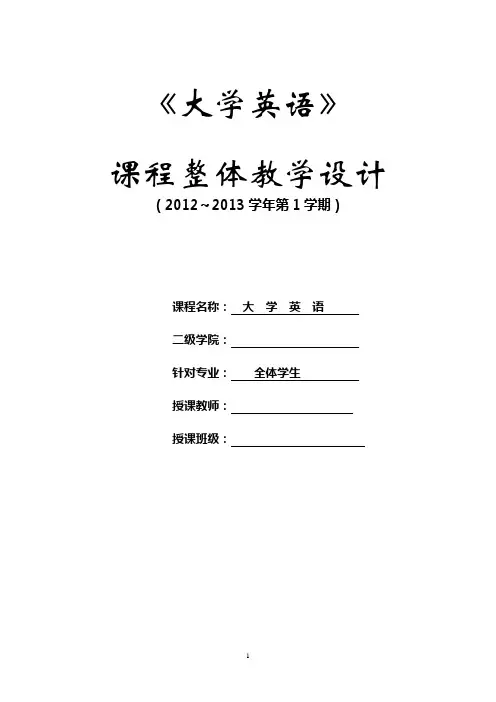
《大学英语》课程整体教学设计(2012~2013学年第1学期)课程名称:大学英语二级学院:针对专业:全体学生授课教师:授课班级:《大学英语(第一册)》课程整体教学设计一、课程基本信息二、课程定位本课程为高职高专院校非英语专业的一门公共必修课,旨在培养和提高学生综合运用英语和在真实场景中使用英语的能力。
本学期英语课程采用基础英语教材,把听、说、读、写、译五项语言技能有机融合,重点在培养学生英语基础知识的掌握和职业核心能力的提高。
本课程强调基础英语知识的掌握和运用,以学生的实际水平为出发点,真正做到学会、会学、会用,在做中学,学中做,把语言知识和实际运用结合。
三、课程目标设计总体目标:能够运用所学知识进行日常的英语交流、阅读和理解简短文章和简单的应用文写作的能力。
能力目标:1. 能够进行问候、致歉、致谢、问/指路、假期及节日等话题的英语口语交流;2. 能听懂问候、致歉、致谢、问/指路、假期及节日等话题的简单对话;3. 能够在自主学习中使用听说读写译技能和策略;4. 能借助工具阅读并翻译简短的英语文章;5. 能运用所学知识写出基本符合要求的感谢信、致歉信。
知识目标:1. 掌握问候、致歉、致谢、问路、假期及节日等话题的常用表达方式;2. 理解并掌握听、说、读、写、译的技巧和策略;3. 了解中西方在问候、致歉、致谢、问路、假期及节日等方面的文化差异;4. 掌握教材中词汇、短语和句式结构的用法;5. 了解英汉思维方式的差异,掌握英汉表达的差异。
素质目标:1. 团队合作、沟通等职业核心能力;2. 问候、致歉、致谢、问路、假期及节日等话题的社交礼仪及文化差异;3. 自主学习、学以致用的能力。
四、课程内容设计:五、能力训练项目设计。
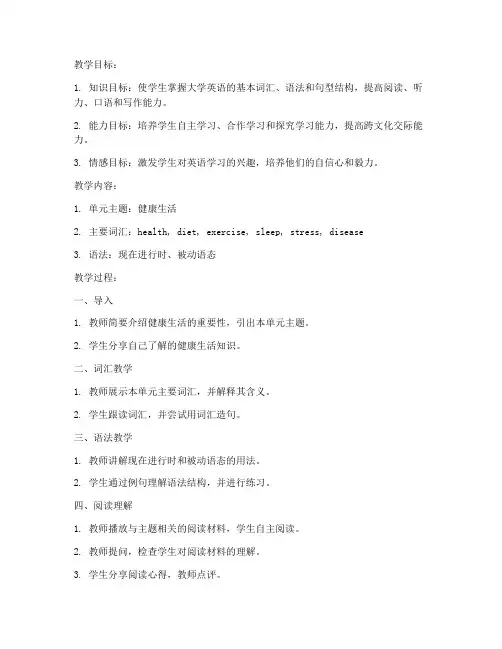
教学目标:1. 知识目标:使学生掌握大学英语的基本词汇、语法和句型结构,提高阅读、听力、口语和写作能力。
2. 能力目标:培养学生自主学习、合作学习和探究学习能力,提高跨文化交际能力。
3. 情感目标:激发学生对英语学习的兴趣,培养他们的自信心和毅力。
教学内容:1. 单元主题:健康生活2. 主要词汇:health, diet, exercise, sleep, stress, disease3. 语法:现在进行时、被动语态教学过程:一、导入1. 教师简要介绍健康生活的重要性,引出本单元主题。
2. 学生分享自己了解的健康生活知识。
二、词汇教学1. 教师展示本单元主要词汇,并解释其含义。
2. 学生跟读词汇,并尝试用词汇造句。
三、语法教学1. 教师讲解现在进行时和被动语态的用法。
2. 学生通过例句理解语法结构,并进行练习。
四、阅读理解1. 教师播放与主题相关的阅读材料,学生自主阅读。
2. 教师提问,检查学生对阅读材料的理解。
3. 学生分享阅读心得,教师点评。
五、听力训练1. 教师播放与主题相关的听力材料,学生自主听力。
2. 教师提问,检查学生对听力材料的理解。
3. 学生分享听力心得,教师点评。
六、口语表达1. 教师设置情景,学生进行角色扮演。
2. 学生用所学词汇和语法进行口语表达,教师点评。
七、写作训练1. 教师讲解写作要求,布置写作任务。
2. 学生根据要求进行写作,教师点评。
八、总结与作业1. 教师对本节课所学内容进行总结,强调重点和难点。
2. 布置课后作业,巩固所学知识。
教学评价:1. 课堂表现:观察学生在课堂上的参与度、发言积极性等。
2. 作业完成情况:检查学生课后作业的完成质量。
3. 期末考试:通过考试评估学生对本单元知识的掌握程度。
教学反思:1. 教师根据学生的反馈,调整教学方法和策略。
2. 关注学生的学习兴趣,激发他们的学习动力。
3. 注重培养学生的自主学习能力,提高他们的英语综合运用能力。
高等职业教育专科英语课程标准(2021年版Navigating the intricacies of the 2021 edition of the Vocational Higher Education Specialized English Curriculum Standards can be akin to charting a course through a dense fog of uncertainty. It's a terrain where clarity is elusive, and confusion often reigns supreme. Yet, within this mazeof directives and guidelines lies a roadmap that, if deciphered correctly, can lead educators and students alike to the shores of proficiency and success.At its core, the 2021 edition of the Vocational Higher Education Specialized English Curriculum Standards represents a pivotal document in the landscape of educational frameworks. It endeavors to outline the competencies, objectives, and methodologies necessary to cultivate a cohort of learners adept in the nuances of English within a vocational context. However, beneath its surface lies a labyrinth of complexities that demandcareful consideration and interpretation.One of the key challenges posed by the curriculum standards is the ambiguity surrounding its implementation. While the document provides a broad overview of the skills and knowledge expected at each proficiency level, it oftenfalls short in delineating the practical strategies for achieving these objectives. This lack of specificity can leave educators grappling with questions of pedagogy and assessment, unsure of how best to tailor theirinstructional approaches to meet the standards' requirements.Moreover, the dynamic nature of language itself presents a formidable hurdle in the realm of curriculum development. The landscape of English is constantly evolving, shaped by cultural shifts, technological advancements, and global trends. As such, any attempt to codify a set of standards runs the risk of obsolescence even before its ink has dried. The 2021 edition of the Vocational Higher Education Specialized English Curriculum Standards must contend with this reality, striving to strike a balance between timeless principles and adaptability to change.Furthermore, the intersection of language and vocation introduces a layer of complexity that is unique to the realm of vocational education. Unlike general English language instruction, which may prioritize proficiency in communication for its own sake, vocational English demands a more targeted approach. Learners must not only master the linguistic structures and conventions of English but also acquire the specialized terminology and skills relevant to their chosen fields. This dual emphasis requires educators to adopt a multidisciplinary perspective, integrating language instruction with vocational training in a seamless manner.In light of these challenges, it is imperative for educators to approach the 2021 edition of the Vocational Higher Education Specialized English Curriculum Standards with a spirit of adaptability and innovation. Rather than viewing the document as a rigid set of mandates, it should be seen as a framework for inspiration and guidance. Educators are encouraged to leverage their creativity and expertise to devise dynamic lesson plans, authentic assessments, and immersive learning experiences thatresonate with the diverse needs and aspirations of their students.Additionally, collaboration and dialogue among stakeholders play a crucial role in navigating the complexities of the curriculum standards. By fostering a community of practice where educators can share insights, resources, and best practices, institutions can cultivate an environment conducive to continuous improvement and excellence in vocational English education.In conclusion, while the 2021 edition of the Vocational Higher Education Specialized English Curriculum Standards may present challenges and ambiguities, it also offers opportunities for growth and innovation. By embracing the spirit of inquiry and exploration, educators can harness the potential of this document to empower learners with the linguistic and vocational skills needed to thrive in an increasingly interconnected and competitive world.。
高职英语1整体课程设计一、教学目标本课程的教学目标是使学生掌握高职英语的基础知识和技能,提高学生的英语听、说、读、写能力,培养学生运用英语进行日常交流和职业沟通的能力。
具体目标如下:1.知识目标:学生能够掌握英语的基本语法、词汇和发音规则,了解英语的文化背景和习俗。
2.技能目标:学生能够听懂日常英语对话和短文,能够流利地进行英语口头表达和书面写作,能够正确使用英语进行阅读和翻译。
3.情感态度价值观目标:学生能够增强自信心,培养对英语学习的兴趣和主动性,培养跨文化交际的意识和平等、参与的国际视野。
二、教学内容教学内容以高职英语教材为主线,包括以下几个方面:1.语音:学生能够正确发音,掌握重音、连读、语调等语音现象。
2.词汇:学生能够掌握日常生活中的基本词汇和短语,了解专业词汇的用法。
3.语法:学生能够掌握基本的语法规则,包括时态、语态、句型结构等。
4.听力:学生能够听懂日常英语对话和短文,能够理解口头信息并进行适当的应答。
5.阅读:学生能够阅读并理解简单的英文文章,能够进行快速阅读和信息检索。
6.写作:学生能够撰写简单的英文文章,包括日记、书信、故事等。
7.口语:学生能够流利地进行日常英语交流,包括自我介绍、问答、讨论等。
三、教学方法本课程采用多种教学方法,包括讲授法、讨论法、案例分析法、实验法等,以激发学生的学习兴趣和主动性。
1.讲授法:教师通过讲解知识点和示例,帮助学生掌握英语的基本语法和词汇。
2.讨论法:教师学生进行小组讨论,培养学生的口头表达能力和团队合作意识。
3.案例分析法:教师提供实际案例,学生通过分析案例来运用所学知识和提高解决问题的能力。
4.实验法:学生通过听力和口语实践,提高实际运用英语进行交流的能力。
四、教学资源本课程需要以下教学资源:1.教材:高职英语教材,用于引导学生学习和练习。
2.参考书:提供额外的学习资料和练习题,帮助学生巩固知识。
3.多媒体资料:包括音频、视频、图片等,用于辅助教学和丰富学生的学习体验。
高职英语课教学设计模板范文In the realm of vocational education, English courses play a pivotal role in equipping students with the necessary language skills for their future careers. The design of such a course must be meticulously crafted to meet the unique needs of the students.The curriculum should begin with an assessment of the students' current English proficiency levels to tailor the teaching methods accordingly. Interactive activities such as role-plays and group discussions can help students practice conversational skills in a supportive environment.Incorporating real-world scenarios into the lessons can make the learning experience more relevant and engaging. For instance, students can be tasked with drafting emails or preparing presentations in English, simulating professional situations they may encounter.Technology integration is essential in modern education. Utilizing online platforms and apps can provide students with additional resources and opportunities to practice English outside the classroom.Assessment methods should be varied to cater to different learning styles. This could include oral presentations, written assignments, and online quizzes, ensuring a comprehensive evaluation of students' language abilities.Cultural awareness is a crucial component of language learning. Introducing students to English-speaking cultures can enhance their understanding and appreciation of the language.Feedback is a vital part of the learning process. Constructive and timely feedback can help students identify their strengths and areas for improvement, fostering a growth mindset.Continuous professional development for the instructorsis also necessary to stay abreast of the latest teaching methodologies and to ensure the course remains dynamic and effective.Finally, the course design should be flexible enough to adapt to the evolving needs of the students and the job market, ensuring that the skills taught are always in demand.。
高等职业教育专科英语课程标准的课程结构依据Higher vocational education plays a crucial role in providing students with the practical skills and knowledge necessary to succeed in their chosen field. The curriculum structure of a vocational college English course must be carefully designed to meet the needs and goals of both students and educators.高等职业教育专科英语课程的课程结构应该根据学生的需求和教育者的目标进行精心设计。
通过综合各方面的需求和考虑,一个完整的课程结构可以有效地提高学生英语水平,提升他们在职场上的竞争力。
One important aspect of the curriculum structure is the sequencing of content and skills. The course should be organized in a logical and progressive manner, with each unit building upon the knowledge and skills learned in the previous units. This can help students to develop a solid foundation in English and gradually expand their language proficiency.课程结构的一个重要方面是内容和技能的顺序。
课程应该按照逻辑和递进的方式组织,每个单元都应该建立在之前学习的知识和技能基础之上。
2021高职专科英语课标Here is an essay on the topic "2021 Higher Vocational College English Curriculum Standards" with more than 1000 words, written in English without any additional title or punctuation marks in the body.The 2021 Higher Vocational College English Curriculum Standards represent a significant milestone in the ongoing efforts to enhance the quality and relevance of English language education in China's higher vocational college system. These standards, developed by a team of experts and stakeholders, aim to provide a comprehensive framework for the design, implementation, and assessment of English language programs in these institutions.At the heart of these standards lies a recognition of the evolving needs and expectations of both students and employers in the 21st-century job market. The curriculum emphasizes the development of practical language skills, with a focus on effective communication, critical thinking, and problem-solving abilities. This shift away from a purely academic approach to language learning reflects the growing demand for graduates who can seamlessly navigate the linguistic and cultural challenges of the global workplace.One of the key features of the 2021 standards is the emphasis on task-based and project-based learning. Rather than relying solely on traditional lecture-based instruction, the curriculum encourages the use of interactive, hands-on activities that simulate real-world scenarios. Students are given opportunities to collaborate on group projects, engage in role-play exercises, and participate in case studies that mirror the challenges they are likely to encounter in their future careers.This experiential approach to learning is further reinforced by the integration of digital technologies into the curriculum. The standards recognize the importance of equipping students with the digital literacy skills necessary to thrive in an increasingly technology-driven world. Accordingly, the curriculum incorporates the use of online resources, multimedia tools, and virtual learning environments to enhance the learning experience and prepare students for the demands of the modern workplace.Another key aspect of the 2021 standards is the emphasis on developing intercultural competence. In an increasingly globalized economy, the ability to navigate cultural differences and communicate effectively across diverse contexts has become a critical skill. The curriculum, therefore, places a strong emphasis on exposing students to a range of cultural perspectives, fostering cross-cultural understanding, and developing the necessaryinterpersonal skills to engage with individuals from diverse backgrounds.To support the implementation of these standards, the curriculum also places a strong emphasis on the professional development of English language instructors. The standards call for ongoing training and support to ensure that faculty members are equipped with the latest pedagogical approaches, technological tools, and cultural awareness necessary to deliver high-quality instruction.Furthermore, the 2021 standards acknowledge the importance of aligning English language education with the broader goals and priorities of China's economic and social development. By emphasizing the practical application of language skills, the curriculum aims to contribute to the country's efforts to cultivate a highly skilled and adaptable workforce capable of driving innovation and economic growth.Overall, the 2021 Higher Vocational College English Curriculum Standards represent a significant step forward in the ongoing evolution of English language education in China. By focusing on the development of practical language skills, the integration of digital technologies, the fostering of intercultural competence, and the professional development of instructors, these standards have the potential to transform the way English is taught and learned inhigher vocational colleges, ultimately preparing students for the demands of the 21st-century job market.。
英语职高教学计划教学目标和要求Teaching Plan for Vocational High School English: Objectives and RequirementsI. IntroductionEnglish is an essential skill for vocational high school students to succeed in today's globalized world. As such, developing a comprehensive teaching plan for English is crucial to ensure that students are well-prepared for their future careers. In this document, we will outline the objectives and requirements of our English teaching plan for vocational high school students.II. Objectives1. To improve students' language proficiency: The primary objective of our English teaching plan is to enhance students' ability to communicate effectively in English. This includes improving their listening, speaking, reading, and writing skills.2. To develop students' critical thinking skills: In addition to language proficiency, our teaching plan aims to cultivate students' ability to think critically and analyze information in English. This will help them to become more independent learners and make informed decisions in their future careers.3. To broaden students' cultural awareness: Another key objective of our teaching plan is to expose students to different cultures and perspectives through English language learning. This will help them to develop a greater understanding and appreciation of diversity in the world.4. To prepare students for further education and employment: Ultimately, our English teaching plan is designed to equip students with the skills and knowledge they need to pursue higher education or enter the workforce with confidence.III. Requirements1. Active participation: Students are expected to actively engage in all English language activities and exercises in the classroom. This includes speaking up, asking questions, and collaborating with their peers.2. Completion of assignments: Students are required to complete all assigned readings, homework, and projects on time. This will help them to consolidate their learning and reinforce their language skills.3. Regular attendance: Consistent attendance is crucial for students to benefit from the English teaching plan. Absencesmay lead to missed learning opportunities and hinder students' progress.4. Respect for others: Students are expected to demonstrate respect for their teachers and classmates at all times. This includes listening attentively, following instructions, and participating in a positive and cooperative manner.5. Continuous self-improvement: Students are encouraged to take responsibility for their own learning and strive for continuous improvement in their English language skills. This may involve seeking extra help, practicing outside of class, or setting personal goals for language development.In conclusion, our English teaching plan for vocational high school students is designed to help them achieve their full potential in the language and prepare them for future success. By focusing on language proficiency, critical thinking, cultural awareness, and career readiness, we aim to equip students with the skills and knowledge they need to thrive in a globalized and competitive world.。